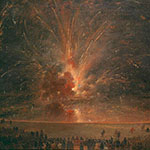Presentation
Water and Fire in the representations of political power in Early Modern Europe
International conference organised by Dénes HARAI and Gaëlle LAFAGE
23-24/03/2017, Paris, France
On the occasion of the third centenary of the death of Louis XIV, the Sun King was commemorated as the “king of fire.” Grand and musical, the “waters” of the Palace of Versailles provided and continue to provide the setting for the festivities and spectacles in accordance with the initial intentions of the Palace’s creators and the use of the estate. Recent research has shown that water and fire – elements which have been most often studied separately in the field of representations – were frequently associated in order to display the omnipotence of political power.
The novelty of this conference lies in the exploration of modalities of this association in representations (writing, painting, sculpture, architecture, medals, etc.) generated by political power (be it papal, episcopal, royal, princely, noble, or urban) in Early Modern Europe (16th-18th centuries). The articulation of water and fire will be examined by each speaker in a work or a series of works, which can be of different natures.
Given the fact that the objective of this conference is to apply an interdisciplinary approach to the analysis of political representations, historians, historians of arts, literature and performance will be brought together around three axes of inquiry to investigate the following questions:
- Contexts and environments:In which contexts were the representations associating water and fire commissioned and created? Can they be linked to particular events: wars, building of a strong state power, catastrophes (floods and fires)? Was the articulation of the two elements more frequent in monarchies than in republics? Was it specific to a heroic way of thinking of the Baroque era or was it also a phenomenon during the Renaissance and the Enlightenment? In what kind of environments (closed and/or open, stable and enduring or mobile and ephemeral) were these elements associated?
- Oppositions and complementarities:To what extent did water enhance fire and vice-versa in the representations of power? Is it possible to distinguish the systematic domination of one element by the other? Were there particular contexts, environments and/or processes that lent themselves to displaying oppositions and complementarities between water and fire? The place of fire fountains and water fireworks is emblematic from this point of view and invites further inquiries while not excluding others.
- Perceptions and receptions: How was the articulation of water and fire perceived by contemporaries (in books, diaries, memoirs and correspondences)? How did depositaries of power assess the representations that they commissioned? How did posterity regard representations of political power using water and fire?
At the end of the conference, it will be possible to have a global view of the sources and references used in Early Modern Europe to represent political power through the association of water and fire. This global view will be a European one due to comparative analysis of case studies presented by the speakers. The conference will also shed light on the methodology that scholars of various Humanities disciplines (History, Art History, Literature) use in order to investigate an interdisciplinary topic which has not yet been explored because of the complexity of its interdisciplinary nature.
Downloadable conference programme


